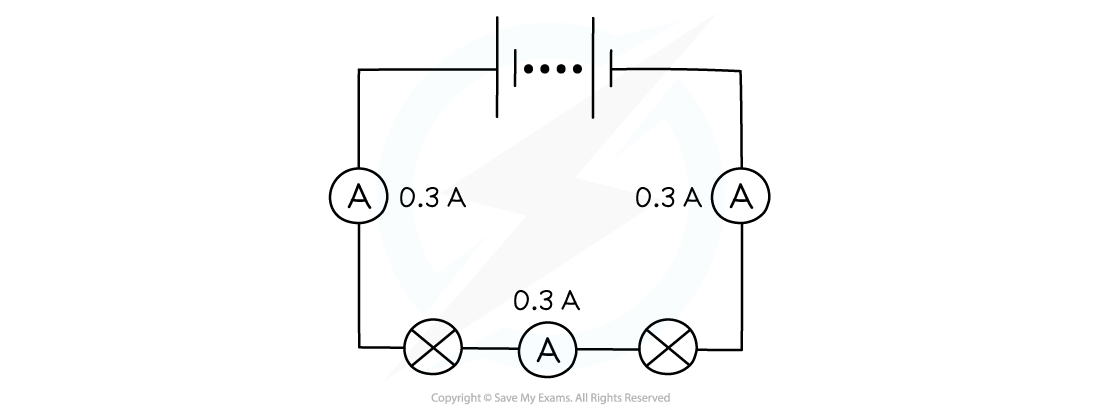Current in Series & Parallel Circuits
Current
- Current is the flow of charge (free electrons) per unit time, around the closed loop of a circuit
- The direction of conventional current is from positive to negative
- Current has the symbol I
Current in Series & Parallel
- A series circuit is a circuit that has only one loop, or one path that the electrons can take
- In a series circuit, the current has the same value at any point
- This is because the electrons have only one path they can take
- Therefore, the number of electrons passing a fixed point per unit time is the same at all locations
- This means that all components in a series circuit have the same current
Current in a Series Circuit

The current is the same at each point in a series circuit
- The amount of current flowing around a series circuit depends on two things:
- The voltage of the power source
- The resistance of the components in the circuit
- Increasing the voltage of the power source drives more current around the circuit
- So, decreasing the voltage of the power source reduces the current
- Increasing the number of components in the circuit increases the total resistance
- Hence less current flows through the circuit
How Voltage and Resistance Affects Current in a Series Circuit

Current will increase if the voltage of the power supply increases, and decrease if the number of components increases (because there will be more resistance)
Current in Parallel Circuits
- A parallel circuit is a circuit that has two or more loops, or more than one path that the electrons can take
- In a parallel circuit, the current has different values at different points in the circuit
- This is because the circuit branches
- Therefore, the electrons have different paths they can take
- The sum of the current in the individual branches is equal to the total current before (and after) the branches
Current in a Parallel Circuit

The current splits at the branches in a parallel circuit
- The advantages of this kind of circuit are:
- The components can be individually controlled, using their own switches
- If one component stops working the others will continue to function
- This is because the electrons can still flow around one closed loop even if the other loop is open
Parallel Circuit with Switches Controlling Individual Components

Diagram showing two bulbs connected in parallel with switches controlling each individual bulb
Measuring Current
- The amount of current flowing through a circuit is measured using an ammeter
- The unit for current is amps (amperes) which has the symbol A
- Ammeters should always be connected in series
An Ammeter Connected in Series

An ammeter connected in series can be used to measure the current around a circuit
Worked example
In the circuit below, ammeter A0 shows a reading of 10 A, and ammeter A1 shows a reading of 6 A. Determine the reading on ammeter A2.
Determine the reading on ammeter A2.
Answer:
Step 1: Recall that at a junction, the current is conserved
- This means that the total amount of current flowing into a junction is equal to the total amount flowing out
Step 2: Consider the first junction in the circuit where current splits
- The diagram below shows the first junction in the circuit

Step 3: Calculate the missing amount of current
- Since 10 A flows in to the junction (the total current of the circuit), 10 A must flow out of the junction
- The question says that 6 A flows through ammeter A1 so the remaining current flowing through ammeter A2 must be:
10 A − 6 A = 4 A
- Therefore, 4 A flows through ammeter A2

